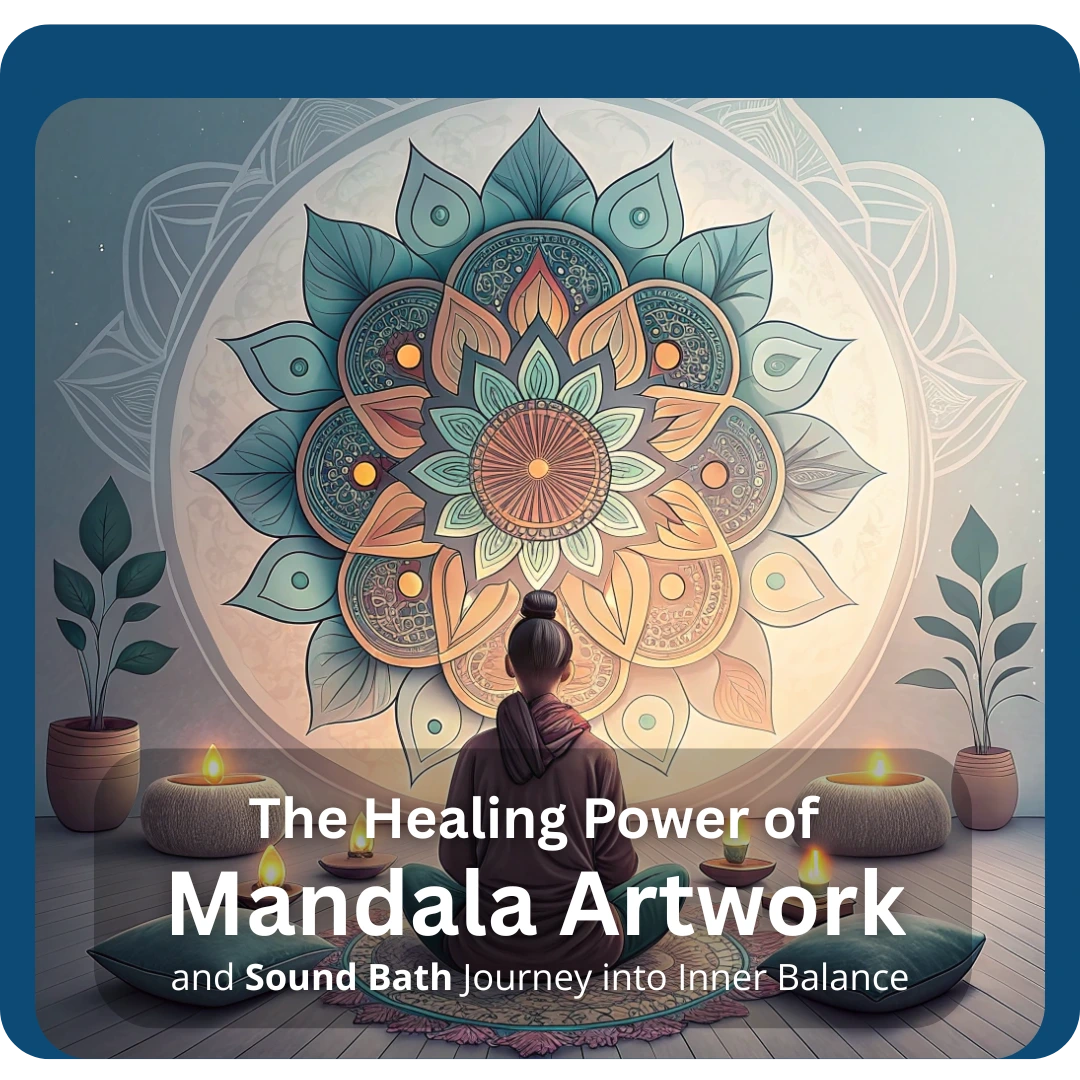The Healing Power of Mandala Artwork and Sound Bath: A Journey Into Inner Balance
Table of Contents
What is Mandala Artwork?
The word Mandala means “circle”—a symbol of wholeness, connection, and infinite possibilities. Across cultures, from Buddhist thangkas to tribal patterns, mandalas have always represented a mirror of our inner state.
But expressive mandala artwork is not about perfection or symmetry. Instead, it’s about:
- Letting go of rigid expectations
- Exploring creativity without judgment
- Mirroring emotions on paper
- Activating intuition and new perspectives
When you sit with a blank circle and allow colors, shapes, and lines to flow, you create a safe space for self-expression. This simple act can release creative blocks, calm the mind, and foster mindfulness.
Mini Practice You Can Try
- Draw a circle on a sheet of paper.
- Add colors, shapes, or lines that reflect how you feel right now.
- Remember—there is no right or wrong. Just flow.
This small ritual can bring surprising insights into your emotional state.
The Science Behind Mandala Artwork
Psychologists believe that drawing or coloring mandalas activates the right hemisphere of the brain—the side linked with intuition, creativity, and emotions. This practice lowers stress hormones, improves focus, and gives the mind a meditative pause. Many therapists now use mandala art as a tool for trauma release and emotional balance.
What is a Sound Bath?
Imagine lying down, closing your eyes, and being immersed in waves of soothing vibrations. That’s the essence of a Sound Bath.
Using instruments like Tibetan bowls, chimes, and rainsticks, a sound healer creates frequencies that gently wash over you. These vibrations help:
- Release stress and emotional tension
- Reset the nervous system
- Induce deep rest and meditation
- Promote emotional healing
A sound bath isn’t just “listening to music”—it’s an energetic reset that works at both conscious and subconscious levels.
The Science of Sound Healing
Sound isn’t just heard by the ears—it’s felt by every cell in the body. Research shows that vibrations from Tibetan bowls or gongs stimulate the vagus nerve, which calms the nervous system. This leads to better sleep, reduced anxiety, and even improved immunity. A one-hour sound bath can sometimes feel like the equivalent of four hours of deep rest.
Why Pair Mandala Artwork and Sound Bath?
When combined, Mandala Art and Sound Bath Healing form a powerful cycle of transformation:
- Mandala → Expression of what’s inside
- Sound Bath → Release, balance, and integration
Together, they create a complete journey—from self-expression to emotional release and inner alignment. This is why many holistic studios now offer sessions where participants first create expressive mandalas and then immerse themselves in a soothing sound bath.
Benefits of Mandala and Sound Bath Healing
- Mindfulness and presence
- Release of perfectionism and stress
- Emotional balance and calmness
- Awakening of intuition and creativity
Deep rest and nervous system healing
Who Can Benefit from Mandala and Sound Bath?
These practices are not limited to artists, musicians, or meditators. Anyone can benefit:
Students struggling with focus
Professionals battling stress and burnout
Women seeking emotional balance
Seniors looking for relaxation and inner peace
Spiritual seekers exploring deeper self-connection
The beauty lies in the fact that no prior experience is needed. All you need is an open heart and willingness to explore.
Final Reflection
In a world where we often suppress emotions and overthink, Mandala Artwork allows you to express, while the Sound Bath allows you to let go. Together, they remind us that healing doesn’t always come from doing more—it comes from allowing flow, silence, and vibration to guide us home.
If you’ve been craving balance, creativity, or simply a break from the chaos, perhaps it’s time to pick up your colors, draw a circle, and let the sounds wash over you.
✨ Want to experience it with a like-minded community?
Join our Healing Circle WhatsApp Group here: Click to Join
It’s a combination of creating mandala art (circular, patterned artwork) and a sound bath session. The art helps focus the mind, while sound vibration supports relaxation and emotional release.
No. Mandala art is not about artistic skill—it’s about expression, focus, and process. Anyone can do it.
A session usually takes about 60-90 minutes, including time for art making, sound bath, and integration.
Yes. Some facilitators offer guided mandala creation + sound bath over video calls. You’ll need art supplies and a quiet space.
Bring minimal art supplies (paper, colors/markers), a mat or cushion, blanket or shawl, water, and wear comfortable clothes.
You may feel calm, more centered, reduced stress, emotional clarity, greater creativity, and a sense of inner peace.
Usually safe. Sometimes people feel emotional release, physical sensations (tingling, warmth), or tiredness after the session. All are normal/temporary.
Even one session can bring relief. For deeper transformation, multiple sessions (2-5) over time tend to give stronger results.
It’s helpful for people feeling stressed, anxious, disconnected, or creatively blocked. Also good for those wanting mindful & nourishing experiences.
Making mandala art helps quiet the mind and open awareness. When paired with sound, it enhances receptivity to the vibrations and supports deeper healing.





I absolutely loved how you described the journey from expressive mandala artwork into the soothing embrace of a sound bath. Pairing those two—first giving form to our inner world through mandala drawing, then releasing and realigning through sound—is such a beautiful ritual for emotional balance. I tried the mini mandala practice just now, and it was unexpectedly calming! Thank you for this gentle yet profound guidance.
This explanation of Mandala Artwork and Sound Bath Healing truly resonated with me! I love how you show the connection between expressing through art and then releasing with sound. It feels like a complete emotional reset — thank you for sharing this insightful journey